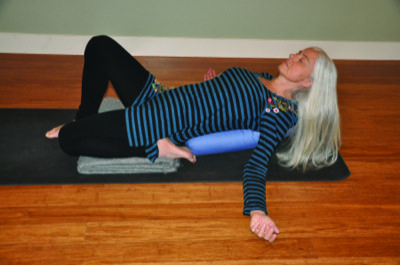The courage to open.
—by Charlotte Bell
What do skiing and sitting in chairs have in common? Not much in terms of musculoskeletal engagement, adrenal activity and sensory delight. However, when you sit and when you ski, your hip joints are in a flexed position, i.e. you are bent forward at the hips.
There’s nothing wrong with flexing at the hip joints; our bodies are meant to do that when we sit, walk, ride a bike or ski. However, too much flexion shortens the front body muscles and weakens the back body muscles. Balance requires that we sometimes extend the front body and flex the back body, as in back bending.
But before you back bend, it’s nice to ease your front body into expansive territory. Practicing Ardha Supta Virasana (Half Reclining Hero Pose) is one way to ease the transition between our usual forward bending and moving into back bending.
Ardha Supta Virasana lengthens and expands front body muscles and connective tissue, including the entire length of the torso and the quadriceps, the big muscles in the fronts of your thighs—all of which shorten with front body flexion. When the front body is open, the digestive organs have more space to function efficiently, making the pose helpful for digestion.
The pose has another winter-related plus: In my own practice, I notice that it also eases sinus congestion. Marlena Lambert, a stellar body worker and yoga teacher, speculates: “In terms of Chinese meridians, the stomach meridian passes through the quadriceps region, but it begins in the face (sinus area, above and below the eyes; it has two branches in the face) and ends in the second toes, which correlates with the tips of the toes as sinus release points in reflexology.” She theorizes that the deep bend and release in both the knee and groin (in doing a forward bend or reclining back) simulates and stimulates the lymph vessels’ own pumping action.
Because of the deep bend in the knees, please proceed with caution, especially if your knees are already compromised. Have a mat, a few blankets, a block and a bolster handy if you have one. Sit on the floor with your knees bent and both feet on the floor. Grab the top of your right foot and bring your knee, shin and top of your foot to the floor next to your right thigh and hip, so that your foot is pointing straight back. If you are collapsing onto your left side, take a blanket or block, place it under your pelvis and sit higher. Continue supplementing your height until both sit bones are evenly grounded.
If the back of your right knee feels compressed, take a sock, squished to about an inch thick, and place it behind your knee. It’s common for the top of the right foot to be uncomfortable because of the extreme extension of the ankle. If that is the case, start over with an extra folded blanket under your shin, letting your foot and ankle fall off the edge.
If you are sitting on a block or higher, stay where you are. If your pelvis is lower, lean back on your hands, lift your pelvis off the floor and extend your tailbone toward your knees. Continue lowering your body. If your knee lifts off the floor or splays out to the side, back off, come up a bit and stay where you can keep your thighs parallel. You may want to support your torso with a bolster, slanted (as shown) or flat on the floor if you can maintain alignment while doing so.
Stay for five to 10 breaths or longer. Staying longer is beneficial unless your knee is uncomfortable. When you come out, stretch your right leg out in front of you and check in with both legs. How do they feel in relation to one another? Do you feel less congested on the right side?
When you practice your second side, start from scratch. Our legs are often vastly different in this pose. Use whatever props you need, even if you didn’t need them on the first side.
I’ve read that Hero’s Pose is named for the courage it takes to sit with the pain that sometimes arises in one’s knees in the pose. I’m not a fan of that interpretation. I don’t believe that sitting with pain in the knees is wise practice. Donna Farhi says, “There’s no good pain in the knees.” I agree. The knees are put together mostly with ligaments. If you are feeling pain in your knees, it is likely that you are stretching a ligament past its healthy limit. There’s nothing heroic about pushing a yoga pose to the point of injury.
I like this interpretation of the name: Virasana opens the front body, exposing the heart and all the other vital organs. When we are afraid or feeling defensive, we often curl forward into our front bodies, protecting our guts from possible outside invasion. Virasana is heroic because it asks us to open our hearts to what’s in front of us. It takes courage to expose our hearts. Ardha Supta Virasana gives us that courage.
